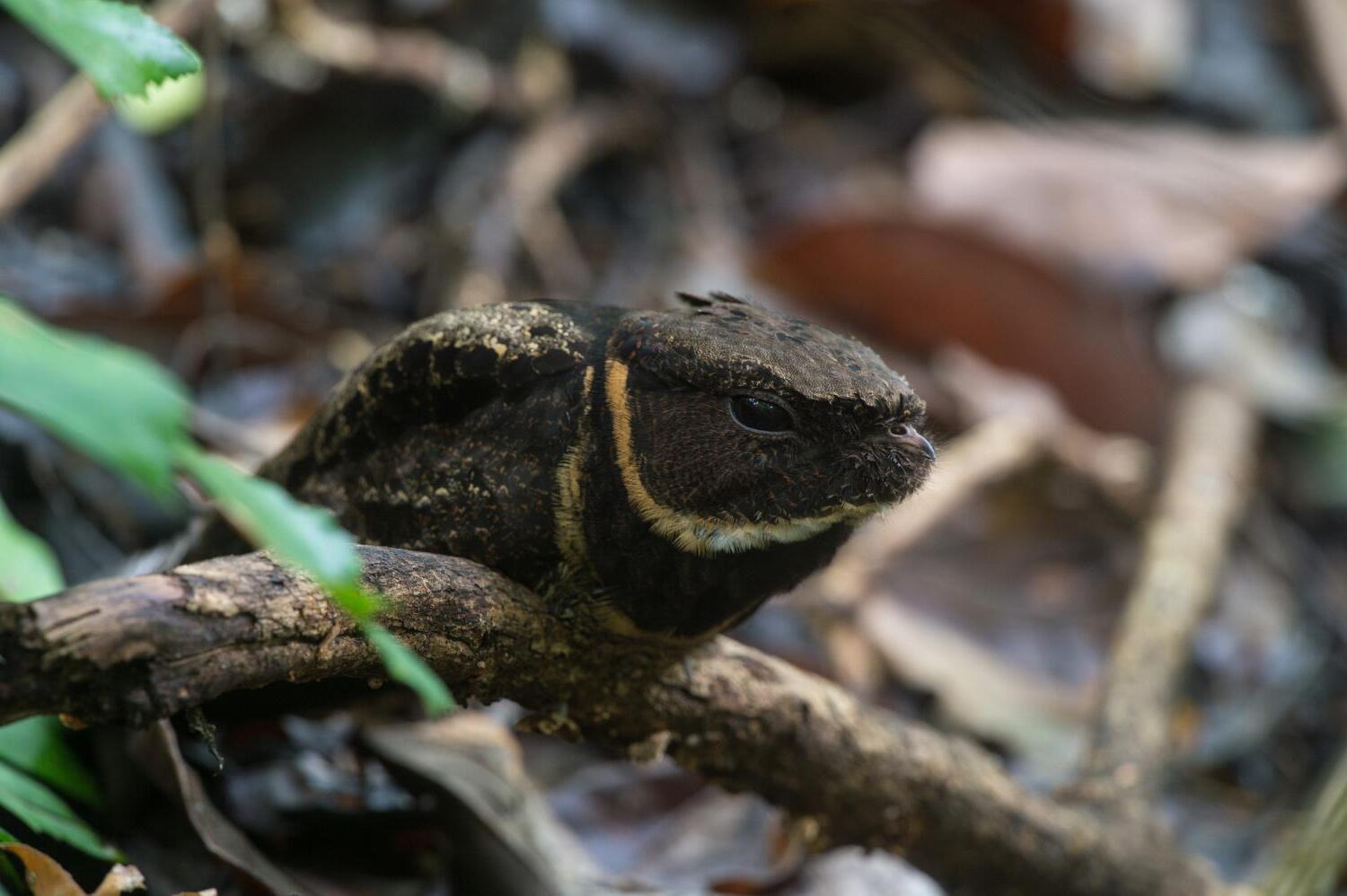
Have you ever heard of a bird that looks like a baby dragon? Meet the Great Eared Nightjar (Lyncornis macrotis), a nocturnal marvel native to Southeast Asia. This bird, with its large round eyes and long ear tufts, is a master of camouflage. Measuring 12 to 16 inches in length and boasting a wingspan of about 28 inches, it blends seamlessly with its surroundings thanks to its mottled plumage. Known for its eerie calls and remarkable ability to drink while flying, the Great Eared Nightjar is a true enigma of the night. Let's dive into 35 intriguing facts about this captivating creature!
Key Takeaways:
- The Great Eared Nightjar is a mysterious bird with a unique appearance and haunting calls, playing a crucial role in controlling nocturnal insect populations in its habitat.
- This enigmatic bird, known for its camouflage abilities and eerie vocalizations, inspires myths and legends, adding to its mystique and cultural significance.
The Enigmatic Great Eared Nightjar
The Great Eared Nightjar is a bird that seems to come straight out of a fairy tale. With its unique appearance and mysterious habits, it has fascinated birdwatchers and scientists alike. Let's dive into some captivating facts about this nocturnal marvel.
Scientific Classification and Physical Traits
Understanding the basics about the Great Eared Nightjar helps us appreciate its unique characteristics.
- The Great Eared Nightjar belongs to the family Caprimulgidae, known for its nocturnal habits and remarkable camouflage abilities.
- This bird has a distinctive appearance, often described as resembling a mythical creature or a baby dragon. Its large, round eyes and long ear tufts give it a unique and striking look.
- Measuring between 12 to 16 inches in length, the Great Eared Nightjar is relatively small but impressive.
- Weighing up to 5.32 ounces, it is light enough to fly silently and maneuverably.
- With a wingspan of approximately 28 inches, it can glide effortlessly through the night sky.
Camouflage and Behavior
The Great Eared Nightjar's survival depends heavily on its ability to blend in and its nocturnal lifestyle.
- Females are larger than males, but both sexes share the same appearance and plumage characteristics.
- Its cryptic plumage consists of shades of brown, black, chestnut, white, gray, and gold, helping it blend seamlessly with its surroundings.
- Known for its distinctive and haunting calls, the bird's vocalizations include a sharp "tsiik" followed by a two-syllable "ba-haaww".
- Being both nocturnal and crepuscular, it is active at night and during dawn and dusk, avoiding predators and hunting effectively in low light conditions.
- Primarily insectivorous, it feeds on a variety of flying insects such as moths and beetles, capturing prey in mid-air with its wide mouth.
Unique Behaviors and Nesting
The Great Eared Nightjar exhibits some fascinating behaviors, especially when it comes to feeding and nesting.
- One unique behavior is its ability to drink while flying, skimming the surface of water bodies to scoop up drops of water.
- Typically nesting on the forest floor, it creates a simple scrape or depression in the ground, well-concealed among leaf litter and debris.
- The female lays a single egg, which hatches in up to four weeks. Both parents tend to the egg and chick, with the female incubating during the day and the male at night.
- Chicks are covered in dull brown down feathers with intricate patterns, enhancing their camouflage abilities.
- Despite their camouflage, they face various predators such as foxes, dogs, crows, owls, and snakes. Habitat loss and human disturbance also pose significant threats.
Conservation and Habitat
While not currently endangered, the Great Eared Nightjar's habitat and conservation status are crucial for its survival.
- Listed as Least Concern on the IUCN Red List, the bird's population is stable, but further research is needed to understand potential threats.
- Found in Southeast Asia, including countries like Thailand, Vietnam, Indonesia, parts of India, and the Philippines, it inhabits dense forests, bamboo thickets, and other tropical and subtropical regions.
- Preferring moist lowland tropical forests and subtropical forests, it can also be found in forest edges and dry shrublands with dense vegetation.
- Possessing a reflective membrane called the tapetum lucidum in the back of its eye, this adaptation enhances its night vision by reflecting light back through the retina.
- Its ability to blend in with its surroundings and its nocturnal lifestyle are key survival techniques, avoiding predators by being constantly on the move and using its agility in flight to evade capture.
Historical and Cultural Significance
The Great Eared Nightjar has a rich history and cultural significance that adds to its mystique.
- First formally described by Irish zoologist Nicholas Aylward Vigors in 1831, its name is derived from its nocturnal behavior and the jarring quality of its calls.
- While there are seven known species of nightjars, the Great Eared Nightjar is one of the largest and most distinctive, with large ear tufts and cryptic plumage.
- A master of nocturnal foraging, its long and broad wings allow it to fly low and slow, making it an effective hunter in the dark.
- Inspiring various legends and myths due to its haunting calls and otherworldly appearance, it is often referred to as a "dragon bird" or "lich fowle" in local folklore.
- Its camouflage abilities are exceptional, with mottled plumage blending seamlessly with the leaf litter and debris on the forest floor.
Ecological Role and Adaptations
The Great Eared Nightjar plays a crucial role in its ecosystem and has several unique adaptations.
- Its nocturnal lifestyle is intricately tied to its feeding habits, being most active at dusk and throughout the night, utilizing keen senses and specialized adaptations to navigate and hunt in low light conditions.
- Vocalizations are distinctive and eerie, ranging from haunting whistles and trills to rhythmic "chop chop" sounds, adding to its mystique.
- As expert aerial insectivores, they are highly skilled at capturing flying insects mid-air, contributing to natural pest control by keeping nocturnal insect populations in check.
- One standout feature is its disproportionately long and distinctive tail, giving the bird its alternative name, the "Large-tailed Nightjar".
- While often found in dense forests and bamboo thickets, it has been spotted in a variety of habitats, including open woodlands, secondary growth, and even gardens in some regions.
Migration and Conservation Efforts
Understanding the migration patterns and conservation efforts for the Great Eared Nightjar is essential for its protection.
- Migration patterns remain a bit of a mystery, with some individuals believed to be migratory, though details are still being studied.
- Much of the nesting behavior remains undocumented due to their secretive nature, with researchers working to uncover more information about their breeding habits, nest locations, and parenting behaviors.
- Inspiring various local legends and folklore, in some cultures, it is seen as a mystical creature with supernatural powers, while in others, it is simply a fascinating bird with unique characteristics.
- Historically compared to various mythical creatures such as dragons and owls, its appearance and behavior have captivated poets and writers, often referred to as "lich fowle" or "dew-hawks".
- Playing a crucial role in its ecosystem, as an insectivorous bird, it helps control nocturnal insect populations, essential for maintaining the balance of nature in its habitats.
Final Thoughts on the Great Eared Nightjar
The Great Eared Nightjar is a truly remarkable bird. Its distinctive appearance, with large ear tufts and cryptic plumage, makes it look like something out of a fairy tale. This bird's nocturnal and crepuscular behavior allows it to thrive in the dark, hunting insects with incredible skill. Its ability to drink while flying and its unique calls add to its mystique. Despite facing threats like predators and habitat loss, the Great Eared Nightjar remains a resilient species, listed as Least Concern on the IUCN Red List. Found across Southeast Asia, it plays a crucial role in controlling insect populations. Understanding and appreciating these facts about the Great Eared Nightjar can deepen our respect for this fascinating bird and its place in the natural world. Conservation efforts should focus on protecting its habitats to ensure its long-term survival.
Frequently Asked Questions
Was this page helpful?
Our commitment to delivering trustworthy and engaging content is at the heart of what we do. Each fact on our site is contributed by real users like you, bringing a wealth of diverse insights and information. To ensure the highest standards of accuracy and reliability, our dedicated editors meticulously review each submission. This process guarantees that the facts we share are not only fascinating but also credible. Trust in our commitment to quality and authenticity as you explore and learn with us.


